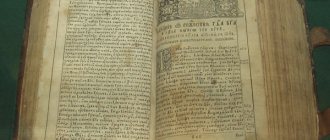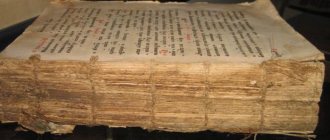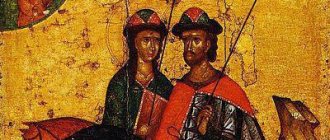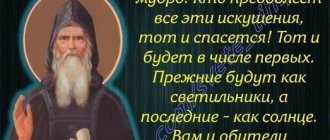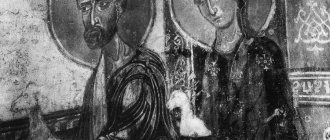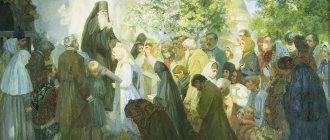Chet'i-Minei is a collection of monuments of ancient Russian literature, compiled by Saint Macarius in the first half of the 16th century. The title of the collection can be translated as “Big Monthly Readings”, since it consists of 12 volumes, which included the lives of saints, works of church writers, collections of patericons, texts of a historical and moralizing nature by Russian authors, arranged in order of celebrating the memory of saints according to the Orthodox calendar on every month. The materials in the collection were approved by the church and were intended for home reading.
about the author
Metropolitan of Moscow and All Rus' Macarius was an outstanding hierarch of the Russian Church. Born in Moscow around 1482, at baptism he was named in the name of Archangel Michael. He received the name “Makarii” when he was tonsured a monk at the Pafnutevo-Borovsky Monastery of the Nativity of the Virgin Mary in honor of the Orthodox ascetic hermit Macarius of Egypt.
In 1526 he was ordained Archbishop of Novgorod and Pskov. Under him, more than 40 churches were built and improved in Novgorod, a pulpit was installed in the St. Sophia Cathedral, new, richly decorated royal doors were made, images of St. Sophia and the Holy Trinity were painted above the entrance to the cohorts.
In 1542 he was elected to the Moscow See as the new metropolitan. In 1547, the Metropolitan of Moscow, for the first time in the history of Russia, crowned the Moscow sovereign Ivan IV. Subsequently, Saint Macarius had a great influence on the tsar and his policies, and was a member of the “Chosen Rada.” In 1552, he blessed the king to set out on a campaign against Kazan and predicted victory. In 1555, in memory of the capture of Kazan, the Cathedral of the Intercession on the Moat, better known today as St. Basil's Cathedral, was founded on Red Square. The Metropolitan personally consecrated this cathedral, a pearl of Russian architecture.
Bishop Macarius died in 1563 and was buried in the Assumption Cathedral. The image of St. Macarius, the Father of the Russian Church, educator and statesman, is immortalized on the “Millennium of Russia” monument, erected in 1862 in Veliky Novgorod. The Metropolitan of Moscow and All Rus' was canonized as a saint in 1988.
Religious activities
As the head of the Russian Church, Saint Macarius convened church councils in 1547 and 1549, during which Russian saints were canonized, and work began on compiling the lives of new saints. In 1551, the famous Hundred-Glavy Local Council was convened, an important decision of which was the rejection of complete secularization. At the same time, restrictions were placed on the further expansion of church lands, and financial restrictions were also introduced on the privileges of the clergy.
Works and creativity
Macarius can be called the patron of printing in Rus'. With his blessing, printing began for the first time in the Kremlin by Deacon Ivan Fedorov. While still the Archbishop of Novgorod, he showed interest in book-writing and literary activities. In 1539, on his initiative, the Novgorod Vladychny Code was compiled, which is a continuation of the chronicle of Novgorod IV, which was based on the Vladychny Code of Archbishop Euthymius. The Archbishop of Macarius continued the traditions of chronicling the past and at the same time reflected the trends of his time, showing the problems of the Novgorod diocese.
Also, under his leadership, a set of canonical rules was compiled, called the Consolidated Helmsman's Book. Another important work of the saint was the famous “State Book of the Royal Genealogy”, compiled on his initiative, which was the first attempt to systematize Russian history. It covers the period from Vladimir the Baptist to Ivan the Terrible and his son Tsarevich Dimitri. The writer glorifies the Moscow monarchy and seeks to establish the idea that royal power is of divine origin. In the 17th century, the Book of Degrees became one of the most widely read works.
The most famous works:
- Novgorod Vladychny Vault;
- Degree book of the royal genealogy;
- Pilot's book;
- Great Chetyi-Minea.
The most significant work is the Great Chetya Menaion of Metropolitan Macarius.
Lives of Saints (Cheti-Minea) of St. Demetrius of Rostov in Russian in 12 volumes
Daniel, which was the name of Saint Demetrius before he was tonsured, was born in 1651 into the family of Maria and Savva Tuptalo near Kyiv. The father of the future saint, thanks to his merits, became a centurion, he conscientiously fulfilled his duties, was often absent from home, his son was raised by his mother, who instilled in her son virtues and piety; looking at her, Daniel was imbued with faith in God.
Having received his primary education at home, Daniil Tuptalo entered the Brotherhood School of Kyiv, where he showed extraordinary abilities in the sciences, diligence, he was especially good at rhetoric, foreign languages, he succeeded in composing sermons, but the main thing for him was not to impress the public, but to preserve inner aspiration towards God. He preferred to retire to read the Holy Scriptures and the works of the Holy Fathers. It was logical that he took monastic vows at the age of seventeen, which took place in the Kirillovsky Monastery in Kyiv; he received a new name - Demetrius.
After asceticism in Kyiv for seven years, Monk Demetrius became a hierodeacon, and then a hieromonk; in 1675, out of obedience, he moved to Chernigov, where his main task was preaching. Then, by the providence of God, Saint Demetrius ended up in the Belarusian Slutsk, he was cordially received by the ktitor of the Transfiguration Monastery.
Hieromonk Dimitri was waiting for the Ukrainian hetman Samoilovich, who convinced him to head the Maksanovsky monastery, before which he received the rank of abbot. It should be noted that before this he was offered to become abbot of other monasteries, but out of humility he refused. His humility is confirmed by the fact that several times in his life he received visions when saints appeared to him, but he kept silent about it. Abbot Dimitri's stay in the Maksanovsky monastery was short-lived: he headed several more monasteries, until in 1684 he ended up in the Kiev Pechersk Lavra, where he wrote the lives of saints; a few years later he received the rank of archimandrite.
Saint Demetrius spent the last years of his life in different parts of Russia: in 1701 he became Metropolitan of Tobolsk and Irkutsk, and a year later he was already in the Rostov Metropolitanate, his movement was regulated by the decrees of Emperor Peter I. Metropolitan Demetrius foresaw his death: he indicated in advance the place of his burial, and during the time allotted to him by the Lord, he worked in the field of educating the local population, and a Slavic-Greek school was opened under him. Saint Demetrius of Rostov passed away on October 28, 1709, was buried in the Yakovlevsky Monastery, and forty-three years later his relics were found.
The famous Chetya-Minea of St. Demetrius are a collection of biographies of Orthodox saints in 12 volumes, each of which corresponds to one of the months of the year when the memory of certain saints is celebrated. They are intended to be read at home by Christians, written in colorful Church Slavonic. Another book by Metropolitan Demetrius, worthy of a place in the home library, is “The Spiritual Alphabet”; it sets the right guidelines in the life of an Orthodox Christian.
See also: Lives of Saints
From the history of the creation of Chetya-Minea
Materials for the Makaryevsky Menyas have been collected for more than 25 years.
The collection was based on various texts, including:
- celebrants;
- hagiographical writings;
- lives of saints;
- Russian and translated texts of the patericons (Alphabetical Jerusalem, Sinai, Egyptian, Skete, Kiev-Pechersk and Consolidated);
- biblical books and explanatory Psalms;
- works of the Church Fathers: Basil the Great, Gregory the Theologian;
- materials from the collections: Chrysostom, Zlatostruya, Margarita, Taktikona;
- charters, acts, charters, apocrypha.
When compiling the Menaion on the basis of ancient texts, new editions and translations were written, and translated works were verified and corrected according to their Greek originals.
Many Russian writers, translators, scribes and scribes worked on the creation of texts:
- theologian Zinovy Otensky;
- writers and publicists: Lev Philologist, Vasily Tuchkov-Morozov, Ermolai Erasmus;
- clerk Dmitry Gerasimov;
- Pskov priest-hagiographer Vasily-Varlaam;
- Presbyter Ilya.
“For the salvation of the soul,” the highest church hierarchs of the 16th century also worked on the Chetya-Menaia: Bishop Savva Cherny of Krutitsy, Archbishop Feodosius of Novgorod, Bishop Joasaph of Vladimir and Vologda. In total, about 27 thousand handwritten pages were written, richly decorated with colorful patterns.
Editorials of Menaion
Three fully completed lists of Makaryevsky Menyas are known. The lists received their names from the places where they were originally stored.
Each list represents an independent edition of the collection:
- Sofia;
- Uspenskaya;
- Tsarskaya.
Materials for the initial edition - the Sofia List - were collected in all Novgorod and Pskov libraries: Vyazhitskaya, Sofia, Otenskaya and others. Work on the Tsar's and Assumption lists was also carried out in Novgorod, but, having become Metropolitan of Moscow and All Rus' in 1542, Macarius was already able to attract scribes and copyists from various monasteries and cities of Russia to work on the lists. And the final preparation of the lists most likely took place under his supervision in the Moscow Metropolitan Scriptorium.
The creation of the Sophia list began in Novgorod at the archbishop's house around 1529 and continued for 12 years. The Sophia list was created on the basis of new and corrected translations of the original Greek texts by the works of various scribes, translators and clerks. As evidenced by the insert notes (“Chronicles” of Macarius), Macarius deposited 12 books from the Sophia list into the Novgorod St. Sophia Cathedral “in commemoration of the souls” of his parents in 1541. Of the 12 books of the Sophia list, only 8 have survived to this day - copies for December were lost , January, March and April. 7 books are part of the Sofia collection of the Russian National Library, and one volume for August is stored in the Central State Archive of Ancient Acts.
Macarius made 12 Assumption volumes as a contribution “for the memory of his soul and for his parents in eternal remembrance” to the Assumption Kremlin Cathedral in 1552, where this set was kept until 1886, after which it was transferred to the Synodal (Patriarchal) library. The Assumption list is the only one of all three that has been preserved in its entirety. It is in the Synodal Collection of the State Historical Museum.
The creation of the Tsar's list, intended for Tsar Ivan the Terrible, continued as early as 1554. In the 17th century, the Tsar's list was kept in the royal chambers. There are two books missing from this list (March, April); the surviving ten books are kept in the Synodal Collection of the State Historical Museum.
About reissues
In the 17th century, the Makaryevsky Menaions were used as the basis for the Menaions of the Chety Chudovskys by German Tulupov in 1600, and in the 17th and early 18th centuries - as the basis for the Menaions of Dmitry Rostov, which began to be published in Kyiv. Dimitri Rostovsky partially supplemented the new collection with materials from Latin and Greek books.
Starting from the middle of the 17th century, the Menaions ceased to be published; all works on collecting the lives of saints were attributed to Demetrius of Rostov. The lives of the saints of the 18th century began to be called “The Lives of the Saints of Demetrius of Rostov.”
The collection was published in 1863-1916. Archaeographical Commission, but only books were published from September to April.
At the beginning of the 21st century, the Menaion had not been published in full in printed or electronic form.
Translation of the text into modern Russian was started by Kirill Melamud in 2021.
The Great Makaryev Chetya Menaion. Edifying reading in Ancient Rus'
Archimandrite Macarius (Veretennikov)
The Great Makaryev Chetya Menaion.
Edifying reading in Ancient Rus'
Veliky Novgorod was an outstanding church, state and cultural center of Ancient Rus'. The most ancient monuments of our national writing are associated with his name. The Novgorod monasteries, as well as the cathedral church of St. Sophia the Wisdom of God and the Novgorod saints, played an active role in its development.
A special place among the Novgorod rulers is occupied by Saint Gennady - theologian and polemicist, biblical scholar and liturgist, who left a unique monument - the biblical corpus, that is, the first complete collection of biblical books in Slavic translation in Rus' and throughout the Slavic world. The successor of his works was Archbishop Macarius of Novgorod (1526 - 1542), later - Metropolitan of Moscow and All Rus' (1542 - 1563). He is already making efforts to collect together all the spiritual literature available in Ancient Rus' at that time.
In the Russian Church by the 16th century there existed various translated and original literature, and there were various books for edifying reading. They were called Chetyi Menaia. Their appearance in Rus' dates back to the Kievan period. They covered the entire annual period and included lives, but not for every day. In subsequent times, the gaps were gradually filled; after the lives, homiletical works began to appear, i.e., edifications and sermons. Such monuments include the Suprasl collection of the 11th century, the Assumption collection of the 12th-13th centuries. Separate volumes of the menaine circle have survived from the 15th century. The first known systematic experience of working on hagiographic monuments, in connection with which a specific name can be named, belonged to the Monk Nil of Sorsky and his students. After the death of Nil Sorsky, which followed on May 7, 1508, the grandiose collection of lives he created - the annual set of the Four Menaions - was rewritten in the Kirillo-Belozersky Monastery. This was the work of several scribes led by Gury Tushin, a student of the Nile.
The various efforts of Russian ascetics and figures in the field of spiritual enlightenment of the previous time found a worthy continuation in the person of St. Macarius. Intensive literary activity took place at the court of Archbishop Macarius. With his blessing, a translation of the “Explanatory Psalter” of Bishop Brunon of Würzburg is being made, the life and service of St. Michael of Klopsky, the life of the Bulgarian martyr George the New are being written, Paschal for the eighth thousand years is being compiled, and chronicle work is being carried out. These works were preceded by the work of the monk Dosifei, nephew of the Venerable Joseph of Volotsk, on correcting the text of the Sinai Patericon in 1528 - 1529, which he did with the blessing of Archbishop Macarius.
In the afterword to the Patericon he wrote: “And now in our land there is such (ascetics - Archim. M.)
there are many, but due to our negligence they are despised and not given over to writing.” The work on the Sinai Patericon is early news of the literary endeavors of St. Macarius and chronologically precedes the beginning of work on the collection of the Menaion of the Four. The desire of the monk Dosifei to collect and record information about domestic ascetics of piety was subsequently expressed in his compilation of the Volokolamsk Patericon. The tasks set by Bishop Macarius were much broader. Taking into account the experience of Archbishop Gennady, Saint Macarius begins collecting and systematizing the hagiographical, homiletical, patristic, spiritual heritage of Ancient Rus', i.e. creation of the Four Mena.
Chetya Menaia means the actual book to be read during a particular month. In ancient times, there were two principles of systematization: the more common was the calendar, reflected in liturgical books, the other appeared somewhat later and was alphabetical (the “ABC Patericon” is known).
Undoubtedly, the great and vigorous book activity of the Bishop was known to everyone. The outstanding writer of the 16th century, the monk of the Oten monastery Zinovy, addressing in a letter to the Novgorod clerk Ya. Shishkin and referring to St. Macarius, wrote “... sir, you live with the divine man of the great Saint and God’s books are revered at every hour.”
In the insert note of the Assumption Menyas, the saint speaks in detail about the contents of the books and about the work on them: “And I wrote this holy great book in Veliky Novgorod, since I was an archbishop there, and I wrote and collected them and collected them into one place for twelve years with many possessions and many different clerks, not sparing silver and any parts, but even more so, many labors and exploits were carried out from the correction and fire of certain ancient proverbs, translating them into Russian speech and how much God has given us to understand as much as we can correct them, and some to this day they have not been corrected and this has been left to us who are able to correct them with God’s help.” A little higher, he gives a description of the content of the Menaion: “And in those Four Menaions all the books of the four are collected, the Holy Gospel, the four interpretive Evangelists and the Holy Apostle, and all the holy Apostolic Epistles, and the Acts with interpretation, and the three great Psalters of different interpreters, and Chrysostom books - Chrysostom and Margaret, and the Great Chrysostom, and the Great Basil, and Gregory the Theologian with interpretation, and the great book of Nikon with his other epistles, and all other holy books are collected and written, in them - prophetic and apostolic, and patristic, and festive words, and words of praise, and the lives of all the holy fathers, and the torment of the holy martyr and holy martyrs, the lives and labors of the venerable and God-bearing fathers, and the sufferings and labors of the venerable saints. And all the holy Patericon were written in the alphabet, Jerusalem, and Egyptian, and Sinai, and monastery, and Pechersk, and all the holy books were collected and written, which are found in the Russian land and with the new saints, miracle workers.”
Recently, some observations have been made about the methodology of work when creating Menaia, about the principle of selecting material for them. The structural basis of the created Menyas was the Prologue, or more precisely, one of its copies, rewritten by order of Archbishop Macarius in 1532 in Novgorod. Its characteristic feature is the presence of a large number of Bulgarian, Novgorod and all-Russian memories. The prologue material was replenished with menaine lives, sermons, that is, the homiletical heritage of the holy fathers, according to the days of the Orthodox Month. Material that could not be dated to a specific day was placed at the end of the manuscript. The fruit of the saint's painstaking twelve-year labors was the Sophia edition of the Four Menaions, given by the saint as a contribution to the Novgorod Cathedral of St. Sophia of the Wisdom of God in 1541.
But collecting and searching is a creative process, therefore the identification of new spiritual treasures with which the Russian Church lived at that time and which existed mainly in its northern borders continued. Taking into account the latter, a new edition of the Menyas, now known as the Assumption Menaions, was undertaken.
In November 1552, on the tenth anniversary of the Primate, a new set of Menaions was given to the Assumption Cathedral of the Moscow Kremlin, which determined their name “Assumption”. Like the Sophia Menaion, the Saint gave them, according to the insert, “in memory of his soul and for his parents in eternal remembrance.” Information about this contribution can also be found in the Memorial Synod of the Kremlin Dormition Cathedral, where the family of Metropolitan Macarius is indicated and further says: “And for those souls, for all their souls, twenty rubles of money were given to Senadik to the Mother of God archpriest Ivan and his brothers for the cathedral, twenty rubles of money, and to the cathedral church of the Assumption twelve for the same souls
Menaions of four great books, all written in the venerable sheet, and in those Menaions of four all the holy books of four are written, which are found in the Russian kingdom and with new miracle workers as a memory of their souls and for their parents in eternal remembrance.”
While work on the Assumption Menaions was being completed, at the request of Tsar John IV, they began to create another such list for him. One scribe who actively participated in this process reports this in a postscript to the manuscript: “And Mokiy wrote, because then there was a command from the Tsar, Grand Duke Ivan, to write holy books in many cities, and in Veliky Novgorod, by the royal command, Thomas then commanded that these holy books be written Sophia priest." Although this speaks of a “command from the king,” it could not have been agreed upon with the metropolitan and not carried out in the school that was nurtured by the saint. The royal copies of the Menaion, in comparison with the Assumption ones, were somewhat expanded in content. Thus, they contain significantly more lives of Russian saints. The protograph of the Assumption Menaion served as the basis for the compilation of the Tsar's Menaion. “The main part of the Tsar’s copy was copied from this collection.” Thus, the entire great enterprise, which began shortly after the arrival of Saint Macarius in Novgorod, was completed by him already in Moscow in the early 50s.
The readings of each day in the Makaryevskaya Chetya Menea contained at the beginning the texts of the usual Prologue and Stishny. This was followed by hagiographic texts from the Menaion of the Fourth, and finally, homiletical works for a given day of the month. On the day of remembrance of the Evangelists or Prophets, their books from the Holy Scriptures or the works of the Fathers of the Church were also placed on the day of their memory. Those materials that could not be dated to a specific day were placed at the end of the Menaion. Their content is very diverse: these are the Explanatory Psalter, and letters of All-Russian Metropolitans, etc.
The Great Makaryevsky Chetya Menaions absorbed monuments of Slavic culture that arose at the dawn of its existence, the first original Russian works, book riches of the house of St. Sophia, Novgorod monasteries, etc. The most Russian monument in the Menaions is the Word on Law and Grace of Metropolitan Hilarion of Kiev (XI c.), placed on July 15 in memory of the holy Equal-to-the-Apostles Prince Vladimir. Subsequent works of Russian origin - the works of Bishop Kirill of Turov, “The Pilgrim” by Abbot Daniel, the hagiographical works of the prolific writer of Ancient Rus', the Athonite hieromonk Pachomius the Serb, etc.
At the same time, we will also find in the Menaion monuments of spiritual literature that were created at the same time as the Menaion. This is the life of the Venerable Paphnutius of Borovsky (already in the Sofia list), the Patericon of Sinai, corrected by the monk Dositheus, the Explanatory Psalter of Brunon of Würzburg, translated by Dimitri Gerasimov, the life of the Venerable Michael of Klopsky, compiled by V.M. Tuchkov, the life of the Bulgarian martyr George (in the Tsar's list) , Pismovnik, lives of Russian saints canonized in the middle of the 16th century. Along with the mass of lives of saints whose authorship is not indicated, the Menaions contain many works, mainly of a homiletical nature, which are signed with the names of various spiritual writers. The list of these Byzantine, Bulgarian and Russian authors is quite impressive.
The most voluminous study devoted to the Great Makaryevsky Menaia Chetiyas belongs to the American researcher D.B. Miller, who tried to see the ideological orientation in their content. “The abundance of texts from the Makaryev collection,” he writes, “showed that Moscow, which was often called the Russian kingdom, is the center of the Christian world, that it is the last of the kingdoms indicated by God.” Various Russian Lives also show the image of the Orthodox sovereign, his patronage of churches and monasteries. The Moscow sovereigns are everywhere called “kings”, “autocrats of all Rus'”. Created shortly before the conciliar trials of the heresies of Matthew Bashkin and Theodosius Kosy, the Menaions contain a variety of anti-heretical works.
The question is legitimate: are the names of the scribes of the Great Makaryevsky Four Menyas known? The Assumption Menaions did not preserve the names of their scribes, since as a result of later bindings they were heavily trimmed and did not retain any marks in the margins. The names of only the scribes of the Tsar's list are known, thanks to the work of G.N. Protasyeva, who described the manuscripts of the Synodal Assembly. It was possible to establish more than five dozen names of the scribes who copied the Royal Menaions, but not all of the scribes’ records have survived to this day, since some were partially or completely cut off during binding, others are now difficult to read, and, finally, two folios from the entire set have not survived to us . Thus, this number of scribes alone sufficiently characterizes the organizational efforts and abilities of Metropolitan Macarius. The created monument, having absorbed the spiritual written treasures of Ancient Rus', itself became the greatest contribution to Russian culture. If the Moscow princes appeared as collectors of the Russian land, then Saint Macarius appeared as a spiritual collector in Rus'.
The Great Makaryevsky Chetya Menaion and the Makaryevsky Councils of 1547, 1549, at which Russian saints were canonized, are interconnected. This is the accumulation of writing and the impetus for its subsequent development. At that time, many lives of Russian saints or their new editions, services, and words of praise were created. At this time, a book typologically new in its content appears, a contemporary of the Great Mena - the Book of New Wonderworkers. That’s what the newly canonized and all Russian saints were called then. Such books contain services, lives, and words of praise to Russian saints. The book of the new Wonderworkers, starting from the middle of the 16th century, became widespread in ancient Russian literature.
The influence of the Makaryevsky Mineas on subsequent minea sets was also great. At the end of the 60s of the 16th century, a yearly cycle of Menaions was created in Alexandrova Sloboda, the original for which was the Assumption list of the Makaryev Four Menaions. Later, these Menaions were given as a contribution by Prince Dimitry Pozharsky to the Solovetsky Monastery. At the turn of the 16th-17th centuries, the so-called Chudov Chetya Menaion were created in the Chudov Monastery. The handwriting tradition of the Makaryevsky Menyas is also observed in them. At the end of the 20s of the 17th century, when Russia experienced the devastation of the Time of Troubles, in the Trinity-Sergius Monastery, Hieromonk German Tulupov created a set of Menaions. The Makaryevsk Menaia, as we remember, sought to collect all the texts together. But there is something in common between the Makaryevsky Menaia and Tulupov’s - these are protographs. In the middle of the 17th century, Trinity priest John Milutin rewrote the annual set of Menaion. The Makariev heritage penetrated here through materials published by that time and the Wall Book.
At the end of the 17th century in Ukraine, the compilation of new Chetyi Menyas began and, for the first time, printing began. Their compiler was Metropolitan Dimitri (†1709; commemorated October 28), who died at the Rostov See. In the “Preface to the Pious Reader”, found in the Menaion, it is said that the source for them, in addition to Greek books, was “partly the Western ancient saints in Orthodoxy who shone forth as the pinnacle of all truth, and the authenticity of the perfection of the great book of the Menaion of the Blessed Macarius Metropolitan Moscow and all Russia, who lived in the year 7064, and the kingdom of the pious Tsar and Grand Duke John Vasilyevich of All Russia, autocrat. Yaty and his Great Book Menaion and the Fourth of Concord for the sake of the written lives of the saints.”
In the last century, the Archaeographical Commission undertook the publication of the Great Makaryev Four Menias. The first September volume was published in 1868-1869. Subsequently, only the October Menaion was published in full, almost the entire November Menaion, partially the December and January Menaion, as well as the hagiographical part of the April Menaion. After the revolution, the Synodal Printing House was closed and the publication of Makaryevsky Menyas ceased.
The idea of the greatness of the Russian land and the need to centralize regional sacred traditions is also imbued with the literary activity of Macarius in compiling the Great Four Menaions. The Great Chetya Menaion of Macarius in its composition represents, first of all, a collection of original translated lives preserved in Rus' from the beginning of Christianity to the middle of the 16th century.
The Great Makaryev Chetya Menaion, preserving the literature of the previous time on its pages, influenced subsequent hagiographic collections; they have been published, studied and are being studied by scientists of various specialties of our day, thereby testifying to the thousand-year tradition of Russian spiritual writing.
Source: Archimandrite Macarius (Veretennikov). The Great Makaryev Chetya Menaion. Edifying reading in Ancient Rus'. "Vyshensky Pilgrim" Journal of the religious association - the brotherhood "Benefactor" in the name of St. Theophan the Recluse of Vyshensky. Ryazan, July 1996. P.60-61.
Literary features
The Chet'i-Minei are a kind of collection of all the literature of Ancient Rus', in which, according to the idea of Metropolitan Macarius, all the books of the Russian land are collected, that is, almost all the spiritual, educational and ecclesiastical narrative literature that existed at that time in Rus'. Each story about an ancient story or life was followed by teachings that were to be read on the days of remembrance of the saints.
Genre features
The menaion genre began to take shape in Byzantium in the 10th century. There were two main types of genre: service, intended mainly for clergy, and general, intended for a wider range of readers of spiritual literature. The composition of the collection is large and varied, so the text is represented by various genres.
Composition
The composition of the work is built in accordance with the idea of arranging the material according to the days and months of the church calendar. In each of the 12 books, the texts are selected and arranged according to the days on which the saint’s memory falls. Those materials that did not lend themselves to the general logic of distribution, that had no connection with the name of any saint, were placed in the last days of the month as a kind of addition.
Language and style
The compilers strove for an equal volume of all books, each of which has approximately 1500-2000 sheets of “Alexandrian” format, divided into two columns, written in half-format and decorated with elegant inserts of the New Byzantine style - a golden background with a predominance of blue designs. The titles are written in clear cinnabar script.
The creation of the collection was preceded by a huge amount of editorial work, which consisted of stylistic processing of the motley material included in the Menaion, in order to present the presentation in a single eloquent, solemn style, since the general style was supposed to emphasize the growing power of the Moscow Orthodox State. The monumentality of the collection is also associated with the idea that Moscow is the heir of Byzantium in the world historical process.
